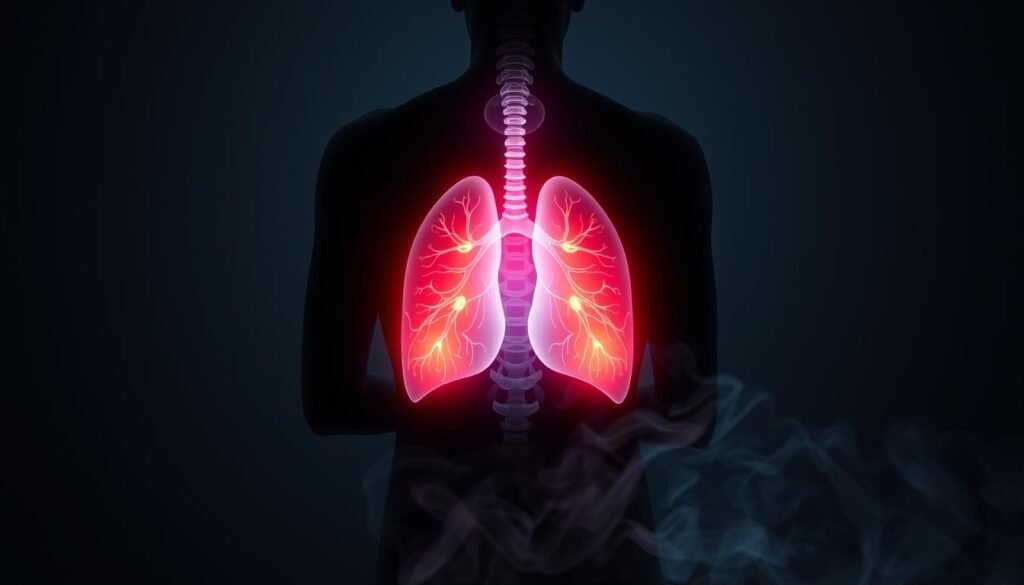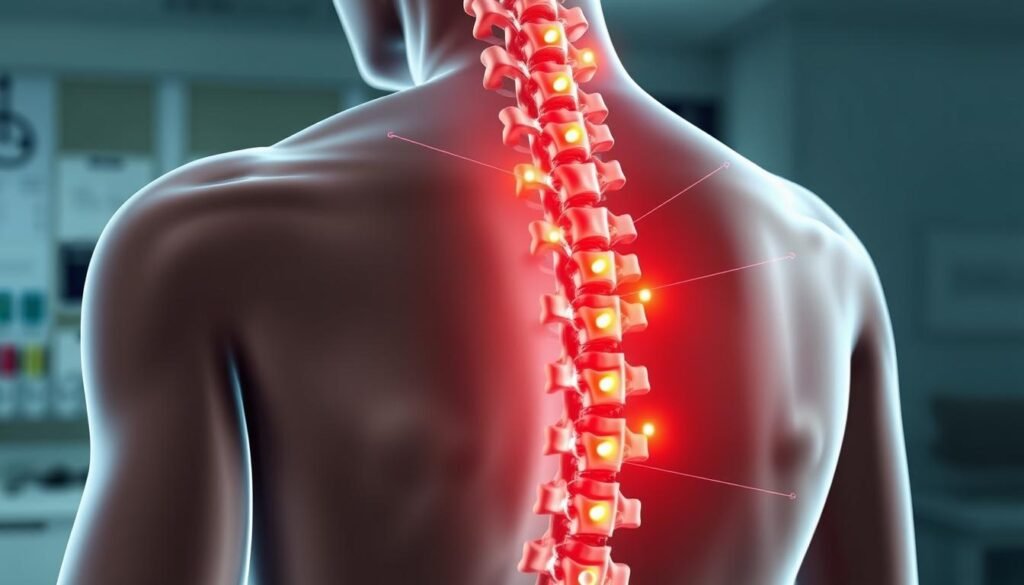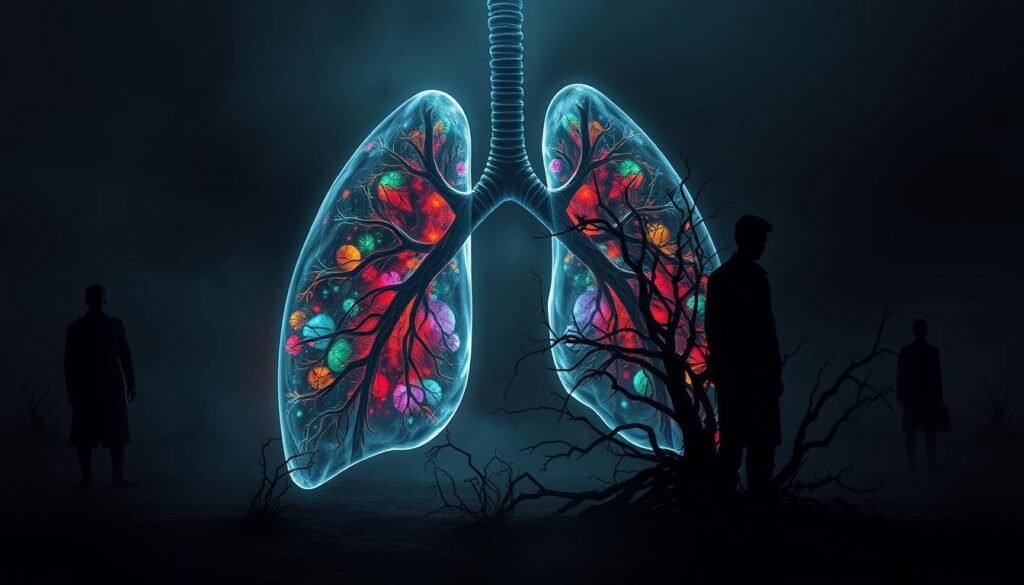Did you know about 25% of people with lung cancer feel lower back pain? This pain often starts before they even know they have cancer. This fact shows how important it is to not ignore back pain. It could be a sign of lung cancer, mainly the type called non-small cell lung cancer (NSCLC).
Many things can cause back pain, but it’s vital to take it seriously. This is especially true if the pain doesn’t go away and you also have symptoms like a constant cough or losing weight without trying. If back pain comes on suddenly and keeps getting worse, getting checked out by a doctor is key. Early detection of the link between lung cancer and back pain can improve treatment results. For more information, click here.
Key Takeaways
- About 25% of individuals with lung cancer report experiencing back pain.
- Back pain may be the first symptom of non-small cell lung cancer (NSCLC).
- Other common symptoms of lung cancer include persistent cough and unintentional weight loss.
- Timely diagnosis is crucial for effective treatment and management of lung cancer symptoms.
- Medical evaluation is necessary for sudden back pain that becomes constant.
- Various treatment options exist to relieve lung cancer-related back pain.
Understanding Lung Cancer and Its Symptoms
Lung cancer symptoms go beyond just back pain. They include a persistent cough, shortness of breath, and chest pain. People might also lose weight without trying. These signs can be easy to miss. It’s very important to see a doctor regularly. Finding lung cancer early can make treatments work better and increase survival rates.
Common Symptoms Associated with Lung Cancer
Knowing the symptoms of lung cancer is key for early treatment. Symptoms to look out for include:
- Persistent cough lasting three weeks or longer
- Wheezing or noisy breathing
- Frequent chest infections
- Loss of appetite and unexplained weight loss
- Chronic fatigue
- Coughing up blood
- Hoarseness in voice
- Swelling in the face or neck
This shows why it’s important to watch your health closely. Tell your doctor if you have these symptoms. It’s a big step in catching lung cancer early.
The Importance of Early Detection
Finding lung cancer early is crucial to improving health. People should get regular checks and talk to doctors about any new symptoms. Spotting signs early leads to early diagnosis. This means treatment can start sooner, which helps a lot. Without action, lung cancer may get worse and limit treatment options.
Lung Cancer Lower Back Pain: A Key Symptom
Lung cancer is known for many symptoms. Lower back pain is a key sign that may appear as the disease gets worse. The link between lung cancer and lower back pain is important. This is because back problems are often misdiagnosed in patients.
Prevalence of Back Pain in Lung Cancer Patients
Up to 25% of lung cancer patients feel back pain. This pain might be the first sign they notice. It happens when tumors press on nearby areas or when cancer spreads to the spine. Spotting back pain early on is key in dealing with lung cancer soon.
How Back Pain Can Be Misdiagnosed
Even with this link, back pain is often wrongly diagnosed. Doctors might think it’s just muscle strain or arthritis. This can cause delays in finding out it’s actually lung cancer. Knowing about symptoms, like back pain from lung cancer, helps patients. They can make sure doctors understand their concerns. Being active in your healthcare is key to getting the right diagnosis and treatment.

The Link Between Lung Cancer and Metastatic Pain
Metastatic lung cancer is a significant concern because it can spread from the lungs to other body parts. This can cause severe pain, especially if it reaches the bones or the spinal cord. It’s crucial for both patients and healthcare providers to understand how this type of cancer works and how to manage the pain.
Understanding Metastatic Lung Cancer
Cancer cells from the lungs can invade bones or tissues near the spine when lung cancer metastasizes. This can cause a lot of discomfort because damaged structures may send out pain signals. Spinal metastases, in particular, can cause back pain, numbness, and weakness in the arms or legs. Spotting these symptoms early is key to starting treatment fast.
Bone and Spinal Metastases Explanation
Bone metastases from lung cancer are pretty common and pose unique challenges in managing pain. For example, patients might face a higher risk of fractures because their bones become weaker. Spinal metastases can also squeeze the spinal cord, causing severe back pain and problems with moving. This shows why it’s crucial to thoroughly check and image patients who have back pain linked to their cancer. Seeking help for these symptoms is important, as explained in resources available online.

The connection between metastatic lung cancer and pain underlines the need for effective treatments. These might include medications, palliative care, and the support of healthcare teams. Noticing changes that could indicate the cancer is getting worse can greatly improve a patient’s life during treatment.
Recognizing the Signs of Advanced Lung Cancer
Knowing the signs of advanced lung cancer is crucial for early treatment. As the disease gets worse, the symptoms become more severe and varied, affecting life greatly. This information helps patients and families get medical help early, which can improve treatment results.
Symptoms of Advanced Lung Cancer
Patients with advanced lung cancer may experience:
- Severe back pain that may spread to other areas, showing tumor growth.
- Unexplained weight loss and fatigue, signs of the body fighting the disease.
- Difficulty breathing, causing feelings of anxiety.
- Persistent coughing and chest pain, which could be mistaken for other issues.
- Bone pain and swelling, often in the back and limbs, from cancer spreading.
How Tumor Growth Affects Surrounding Tissues
Tumor growth can cause pain by compressing nearby tissues and organs. This can get very uncomfortable. As cancer advances, it may move to the bones, including the spine, especially in lung adenocarcinoma. About 39% of those patients experience bone metastasis.
Patients often link back pain to the cancer that has spread. It highlights why thorough checks by doctors are important.

Understanding these symptoms and their connection to tumor growth improves patient-doctor communication. Early detection of these signs can lead to treatments that focus on both immediate and future needs. This helps those dealing with this difficult disease.
Diagnosis of Lung Cancer Related Back Pain
Finding out the cause of back pain linked to lung cancer is key. Doctors must first understand where the pain comes from. They use different tools specially made for checking back pain.
Importance of Medical Evaluation
If you have back pain and might be at risk for lung cancer, seeing a doctor soon is important. Getting checked early can help start treatments sooner, which can make a big difference. Doctors look at how your pain feels, how long it lasts, and other signs. These clues can help find cancer early.
Diagnostic Tools from Your Healthcare Provider
Your doctor has many ways to figure out if your back pain is due to lung cancer. They might use:
- X-rays: These can show if there’s anything unusual with your bones.
- CT scans: These give clear pictures of your insides, helping to find tumors in the lungs.
- MRI: This is best for looking at soft parts, like the spinal cord and disks.
- PET scans: These can show if cancer has spread by checking for active tissues.
- Blood tests: These can check for signs like calcium levels, suggesting cancer might have spread to the bones.
Noticing lung cancer signs early, especially when it might affect the spine, lets doctors start the right treatment quickly.
Treatment Options for Lung Cancer Lower Back Pain
Lung cancer patients often feel a lot of discomfort, especially lower back pain. It’s important to find the right treatment to improve life quality. Treatment choices depend on what’s causing the pain and how bad it is. Using different methods together can help make people feel better overall.
Medication Management for Pain Relief
Many start with medication when battling lung cancer back pain. Simple medicines like acetaminophen or NSAIDs might work for lighter pain. Those with stronger pain might need something more powerful, like opioids. Doctors watch closely to adjust meds and lessen side effects.
Role of Palliative Care in Pain Management
Palliative care is key for lung cancer patients. It focuses on both body and mind. Treatments like physical therapy, acupuncture, and counseling help manage pain and improve well-being. These methods help patients deal with their condition for better pain relief and overall health.
| Treatment Type | Description | Effectiveness |
|---|---|---|
| Over-the-Counter Medications | Includes acetaminophen and NSAIDs. | Effective for mild to moderate pain. |
| Prescription Medications | Includes opioids and stronger pain relievers. | Effective for severe pain. |
| Physical Therapy | Helps strengthen muscles and improve mobility. | Effective in reducing discomfort. |
| Acupuncture | Alternative therapy using needles to relieve pain. | May help in pain management. |
| Psycho-social Support | Includes counseling and psychological support. | Essential for coping with emotional challenges. |
Managing Cancer Pain Effectively
Cancer pain management needs a thorough plan beyond just medicines. Knowing all aspects of pain helps find better relief methods. Patients face different pain types. Techniques like physical therapy and massage offer new ways to ease pain. These methods can make the treatment for back pain from lung cancer better.
Alternative Therapies for Pain Relief
Adding alternative therapies can greatly improve cancer pain care. Practices like yoga and meditation help with relaxation and emotional health. They reduce some of the pain feelings. A mix of drug and non-drug treatments gives patients better results.
Specialist Referral for Holistic Care
Seeing specialized doctors can open up more complete care options. A team that includes oncologists and palliative care experts creates personalized plans. These plans use the newest pain management research. Patients should talk to their doctors about their pain and any treatment side effects. This conversation helps tailor their care better.
| Type of Therapy | Description | Benefits |
|---|---|---|
| Physical Therapy | Targeted exercises to improve mobility and reduce pain. | Enhanced strength and flexibility, greater pain relief. |
| Massage Therapy | Manipulative techniques applied to the muscles and soft tissues. | Improved relaxation, reduced muscle tension, and pain. |
| Acupuncture | Insertion of needles at specific points to relieve pain. | Potential reduction in pain levels and improved overall well-being. |
| Yoga & Meditation | Mind-body practices focusing on relaxation and mindfulness. | Reduction in stress, anxiety, and perception of pain. |
Treating cancer pain is a continuous effort that may need changes as the patient’s condition evolves. Highlighting alternative pain therapies and comprehensive care can enhance pain management for lung cancer patients. For more info, visit pain management guidelines.
Patient Experiences and Overcoming Challenges
Lung cancer survivors often talk about their experiences with back pain. It changes their daily lives, affects their sleep, and harms their quality of life. They find ways to manage this pain and make changes in their lives.
Stories from Lung Cancer Survivors
Survivors share how lung cancer and back pain have affected them. They talk about the struggle of going through diagnosis and treatment. Many find support groups helpful, where they can connect with others who understand their journey.
The Impact of Back Pain on Quality of Life
Back pain does more than just hurt. It makes everyday tasks hard, affecting survivors’ independence. This pain can also disturb sleep and cause anxiety, impacting family relationships. It shows the need for support for survivors and their caregivers.
Conclusion
Understanding symptoms like lower back pain is key in catching lung cancer early. In 2009, lung cancer caused 28% of all cancer deaths in the U.S. Every year, thousands are diagnosed, many feeling back pain along their journey.
Knowing the link between back pain and lung cancer helps. It leads to seeking help faster, which can better the results. When lung cancer gets serious, it can spread to the spine. Talking openly with doctors about any new symptoms is essential.
Growing awareness is vital. It drives people to get checked early, especially those at higher risk. Staying ahead of lung cancer can improve life quality and may increase survival chances with the right treatments.